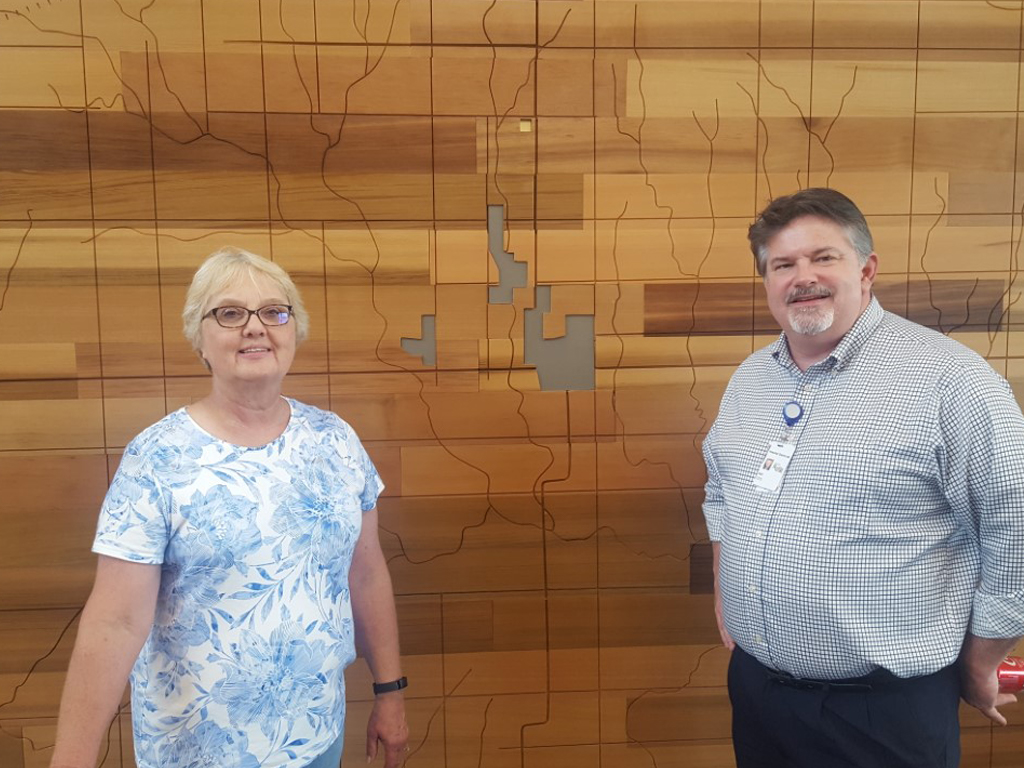Martha Hadsall and Pat Patton | Download this photo.
Kansas Profile – Now That’s Rural: Patterson Health Center
July 3, 2019
One plus one equals ten. Well, it’s obvious that I flunked new math. But today we’ll learn about one community which got together with another to co-create an exceptional new model of health care delivery in rural America.
Martha Hadsall is chair of the board of directors of the Patterson Health Center, a new health care facility in Harper County. Martha, a long-time teacher in Harper, was also involved with the local hospital.
Anthony, population 2,269, and Harper, population 1,473, are Harper County’s two largest communities, located 9 miles apart. Both had small, financially struggling hospitals. In 2012, a community health needs assessment identified integration between the two hospitals as the top concern. However, the two towns were longtime rivals.
In 2015, a proposal came from Neal Patterson, a native of Anthony who had grown up on a nearby family farm. According to the stories, when working in the fields, his father told Neal and his brothers to “do one more round after sundown.” Neal Patterson carried that work ethic and a brilliant mind into a career in medical information technology. He co-founded the highly successful Cerner Corporation in Kansas City.
Patterson was aware that the hospitals back in his home county were struggling with future plans. “He told us that if we were to do research on a merger that could create a new model of health care delivery, he would be our biggest benefactor,” Martha said.
Extensive research followed. Studies found that a new facility was the most financially sustainable option. The board committed to not increase property taxes for the new facility, and to not require a reduction in staff employment.
Following a successful petition drive, the two hospital districts merged and developed plans for a new joint facility. In 2017, the Patterson Family Foundation made a $35 million commitment to the new facility. Sadly, Neal Patterson passed away from cancer, but the commitment remained.
The boards selected the new site on 60 acres next to the shared high school, approximately halfway between Harper and Anthony. “We want to build connections,” Martha said. The next step was to design a state-of-the-art medical facility called the Patterson Health Center.
“It is intentionally called a health center, not a hospital,” Martha said. “We’re about health, not sickness.” It’s based on an integrated care model.
In addition to state-of-the-art equipment, the inpatient, outpatient, and emergency services are structured to maintain privacy, meet modern needs, utilize technology, and encourage collaboration among physicians and specialists. The facility will also include a rehabilitation area, hydrotherapy pool, tornado shelters, helipad, outdoor patios, and a café open to the public. Pat Patton was hired as CEO.
“Our theme is `Together for a healthy future,’ and the architects created `Two communities under one roof,’” Martha said. Together, the two hospital districts are able to eliminate duplication and achieve benefits. For example, the two existing hospitals each had what is called a 16 slice CT scanner, which required each one to have a $40,000 maintenance policy. The Patterson Health Center will have one new 64 slice CT scanner which operates in a matter of microseconds.
Inside the entrance, there is a beautiful wooden display of a map of the health center’s service area from Wellington to Medicine Lodge. Anthony and Harper are shown in the center, with Patterson Health Center in between. Outlying rural communities are shown as well, such as Milan, population 82, Danville, population 38, and Freeport, population 5 people. Now, that’s rural.
At the staff entrance, there is a huge and beautiful rendering of a pretty prairie sunset. “It’s a reminder to the staff of what Neal Patterson’s father said, to `make one more round after sundown,’” Martha said.
The Patterson Health Center is to be dedicated on July 19, 2019. See www.hhd5.com for more information.
One plus one equals ten. No, it’s not new math. It’s an example of two communities coming together to create something great. We commend Martha Hadsall, Pat Patton, and all those who are making a difference by creating this new model of rural health care. I hope it becomes a perfect 10
Audio and text files of Kansas Profiles are available at http://www.kansasprofile.com. For more information about the Huck Boyd Institute, interested persons can visit http://www.huckboydinstitute.org.
----------------
The mission of the Huck Boyd National Institute for Rural Development is to enhance rural development by helping rural people help themselves. The Kansas Profile radio series and columns are produced with assistance from the K-State Research and Extension Department of Communications News Media Services unit. A photo of Ron Wilson is available at http://www.ksre.ksu.edu/news/sty/RonWilson.htm.


